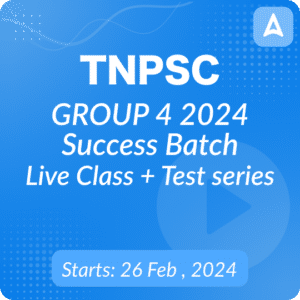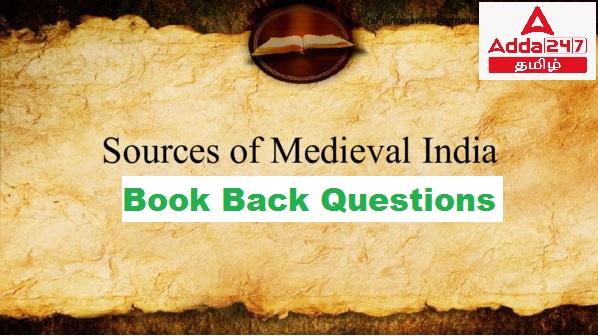TNPSC Samacheer Book Back Questions: ADDA 247 Tamil is giving you TNPSC Samacheer Book Back Questions – Sources of Medieval India MCQs for all competitive exams. Here you get Multiple Book Back Choice Questions and Answers. Here you will find all the important questions and answers that will help you increase your knowledge and move you toward fulfilling your goals. Study these TNPSC Book Back Questions MCQs and succeed in the exams.
Attend TNPSC Book Back Question Quiz Here
Q1. ____________ are the writings engraved on solid surfaces such as rocks, stones, temple walls and metals.
(a) Chronicles
(b) Travelogues
(c) Coins
(d) Inscriptions
S1.Ans.(d)
Sol.
- Primary Sources: Inscriptions, monuments and coins, and the information available in them.
- Secondary Sources: Literary works, chronicles, travelogues, biographies and autobiographies.
- Inscriptions are writings engraved on solid surfaces such as rocks, stones, temple walls and metals.
- Temples, palaces, mosques, tombs, forts, minars and minarets are called by the collective name monuments.
Q2. _____________ was the land gifted to temples.
(a) Vellanvagai
(b) Shalabhoga
(c) Brahmadeya
(d) Devadana
S2.Ans.(d)
Sol.
Various types of lands gifted by the Chola kings are known from the inscriptions and copper plates. They are:
- Vellanvagai – land of non-brahmin proprietors
- Brahmadeya – land gifted to Brahmins
- Shalabhoga – land for the maintenance of a school
- Devadana – land gifted to temples
- Pallichchandam – land donated to Jaina institutions
Q3. _____________period was known as the period of devotional literature.
(a) Chola
(b) Pandya
(c) Rajput
(d) Vijayanagara
S3.Ans.(a)
Sol.
- Devotional movement in South India and later in North resulted in the development of bhakti or devotional literature.
- The Chola period was known as the period of devotional literature.
- Kamba Ramayanam, Sekkizhar’s Periyapuranam,Nalayira Divyaprabhandham, composed by12 Azhwars and compiled by Nathamuni,
- Devaram composed by Appar, Sambandar and Sundarar and compiled by NambiyandarNambi, Manikkavasakar’s Thiruvasagam, all were scripted during the Chola times.
- Jayadeva’s Gita Govindam (12th century) was a follow-up of the Bhakti Movement in South India.
- Kabir Das, a 15th-century mystic poet, also influenced the Bhakti Movement in India.
Q4. _________ provides information about the first Sultan of Delhi.
(a) Ain-i-Akbari
(b) Taj-ul-Ma’asir
(c) Tuzk-i-Jahangiri
(d) Tarikh-i-Frishta
S4.Ans.(b)
Sol.
- In the 13th century,Hasan Nizami, a migrant from Ghazni wrote.
- Taj-ul-Ma’asir towards the end of Iltutmish’s rule.
- It provides information about Qutb-uddin Aibak and is considered the first official history of the Delhi Sultanate.
Q5. _____________ , an Arab-born Morocco scholar, travelled from Morocco to India.
(a) Marco Polo
(b) Al Beruni
(c) Domingo Paes
(d) Ibn Battuta
S5.Ans.(d)
Sol.
- Ibn Battuta (14th century), an Arab-born Morocco scholar, travelled from Morocco right across North Africa to Egypt and then to Central Asia and India.
- His travelogue – Rihla [The Travels]
II Fill in the Blanks:
- ___________ inscriptions provide details about administration in a Brahmadeya
Village. (Uttiramerur)
- ___________ had stamped the figure of Goddess Lakshmi on his gold coins and
had his name inscribed on it. (Muhammad Ghori)
- 3.6 grains of silver amounted to a___________. (jital)
- ______________ was patronised by Sultan Nazir-ud-din Mahmud of the Slave Dynasty. (Minhaj-us-Siraj)
- An Italian traveller _____________ visited Vijayanagar Empire in 1420. (Nicolo Conti)
III
Q6.Match the following:
- Khajuraho – Odisha
- Konark – Hampi
- Dilwara – Madhya Pradesh
- Virupaksha – Rajasthan
(a) 4 1 2 3
(b) 2 3 1 4
(c) 3 1 4 2
(d) 1 4 2 3
S6.Ans.(c)
Sol.
The medieval Khajuraho monuments (Madhya Pradesh) and temples in Konark (Odisha) and Dilwara (Mt.Abu, Rajasthan)
IV State true or false:
- Pallichchandam was the land donated to Jaina institution. (true)
- The composition of metal coins gives us information on the political condition of the empire. (true)
- The high cost of copper made palm leaf and paper cheaper alternatives for recording royal orders and events in royal courts. (true)
- Domingo Paes, a Portuguese traveller, visited the Chola Empire in 1522. (false)
V Match the statement with the reason Tick ( √ ) the appropriate answer.
Q7.Assertion(A) :- Muhammad Ghori’s gold coins carried the figure of Goddess Lakshmi.
Reason (R) :- The Turkish invader was liberal in his religious outlook.
(a) R is the correct explanation of A.
(b) R is not the correct explanation of A.
(c) A is wrong and R is correct.
(d) A and R are wrong.
S7.Ans.(a)
Sol.
- Muhammad Ghori had stamped the figure of Goddess Lakshmi on his gold coins and had his name inscribed on it.
- This coin tells us that this early Turkish invader was in all likelihood liberal in religious outlook.
Q8.Find out the wrong pair:
(a) Madura Vijayam – Gangadevi
(b) Abul Fazal – Ain-i-Akbari
(c) Ibn Battuta – Tahquiq-i-Hind
(d) Amuktamalyatha – Krishnadevaraya
S8.Ans.(c)
Sol.
- Madura Vijayam – Gangadevi
- Amuktamalyatha – Krishnadevaraya
- Ibn Battuta – (Rihla [The Travels])
- Abul Fazal’s – Ain-i-Akbari
(c) Find out the odd one:
Inscriptions, Travelogues, Monuments, Coins,
**************************************************************************

| Adda247 TamilNadu Home page | Click here |
| Official Website=Adda247 | Click here |



